Abstract
1. As mental rehearsal of movements activates multiple cortical areas associated with movement, we assessed whether this increases fusimotor drive and whether enhanced muscle spindle activity could contribute to the improvement in skill that accompanies mental rehearsal. 2. Microneurographic recordings were made from six muscle spindle afferents innervating extensor muscles in the forearm or tibialis anterior, which were selected because their discharge increased during very weak contractions. Activity was monitored while subjects imagined performing a range of activities including simple and complex movements involving the relevant muscles. 3. No activation of muscle spindle afferents occurred during imagined motor tasks without EMG. When the relevant muscles contracted during mental rehearsal, spindle discharge increased, much as in weak contractions. 4. Mental rehearsal increased background EMG in the involved muscles and also increased H reflex amplitude independently of EMG changes. 5. Although there was no evidence for selective fusimotor activation during imagined movement, skeletomotor activity and reflex excitability increased. Similar changes occur with preparation for movement following a cue. It is likely that mental rehearsal usually involves unintentional performance of the planned motor task.
Full text
PDF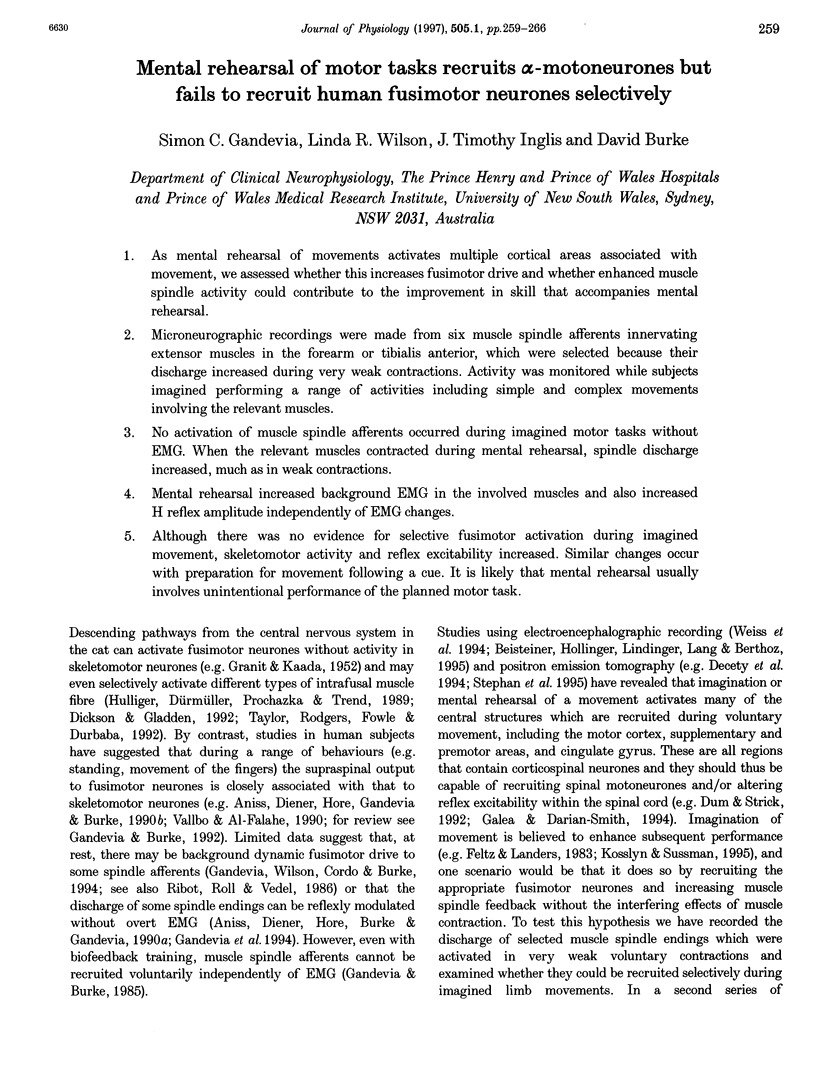
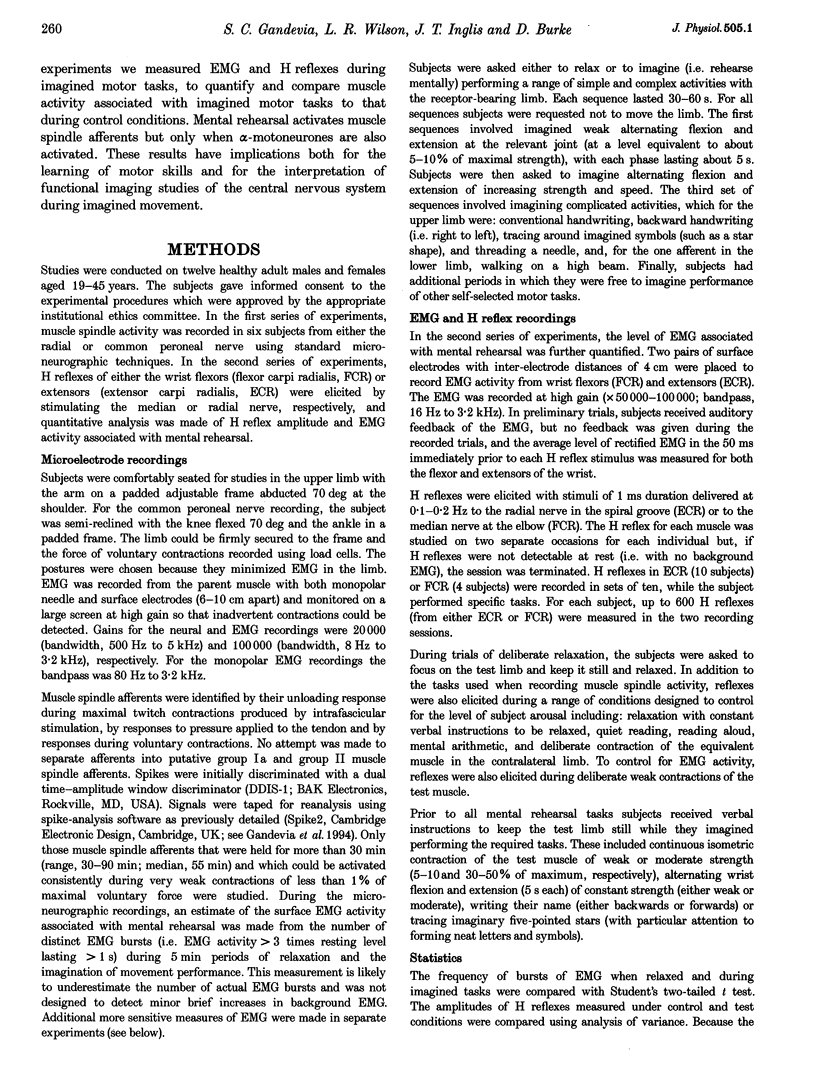
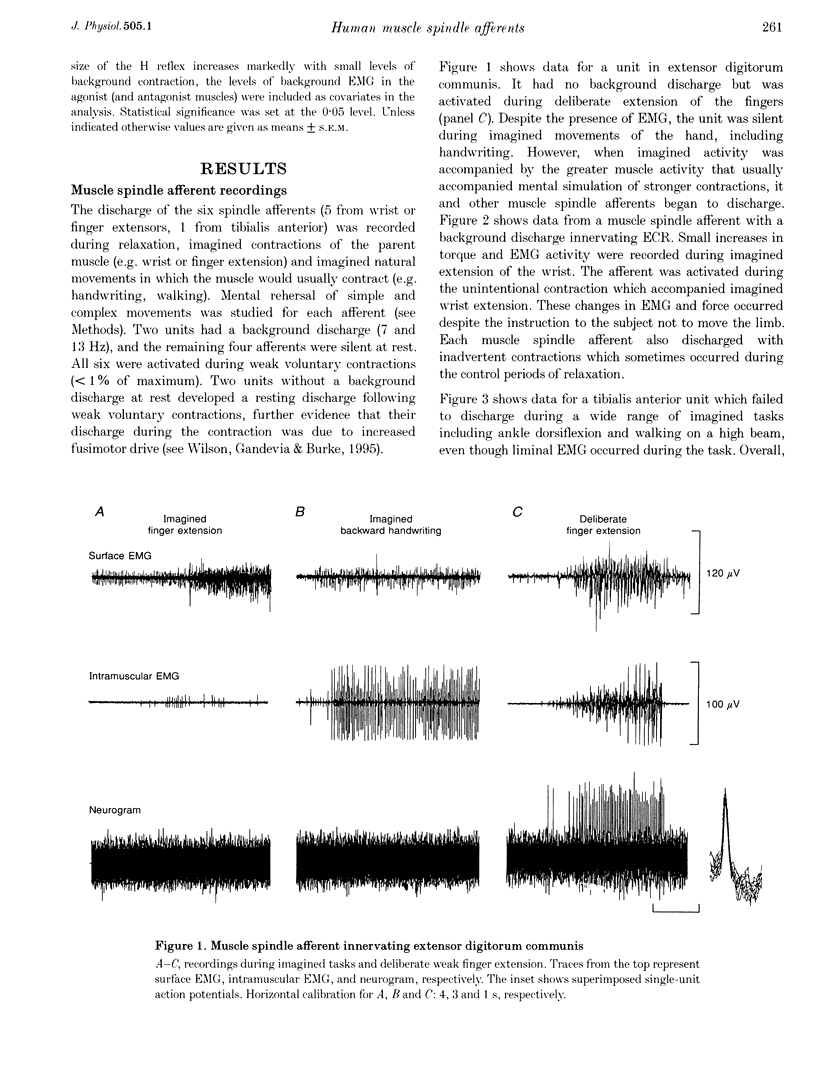
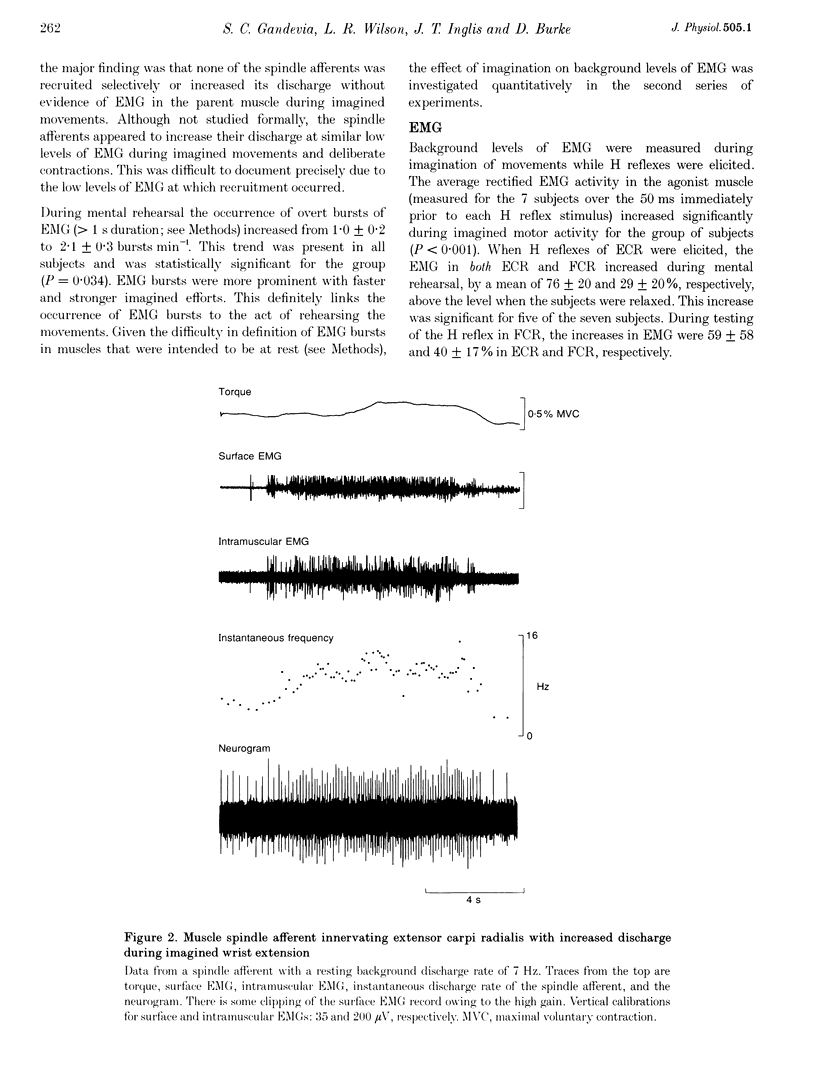
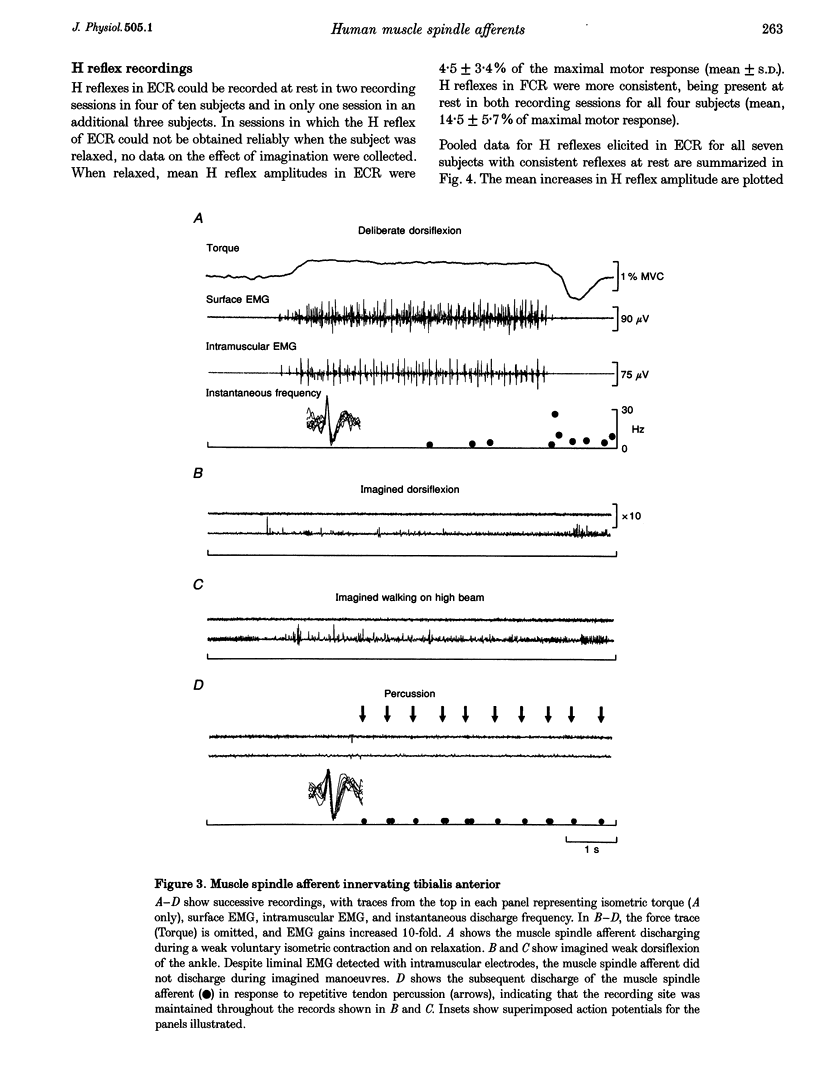
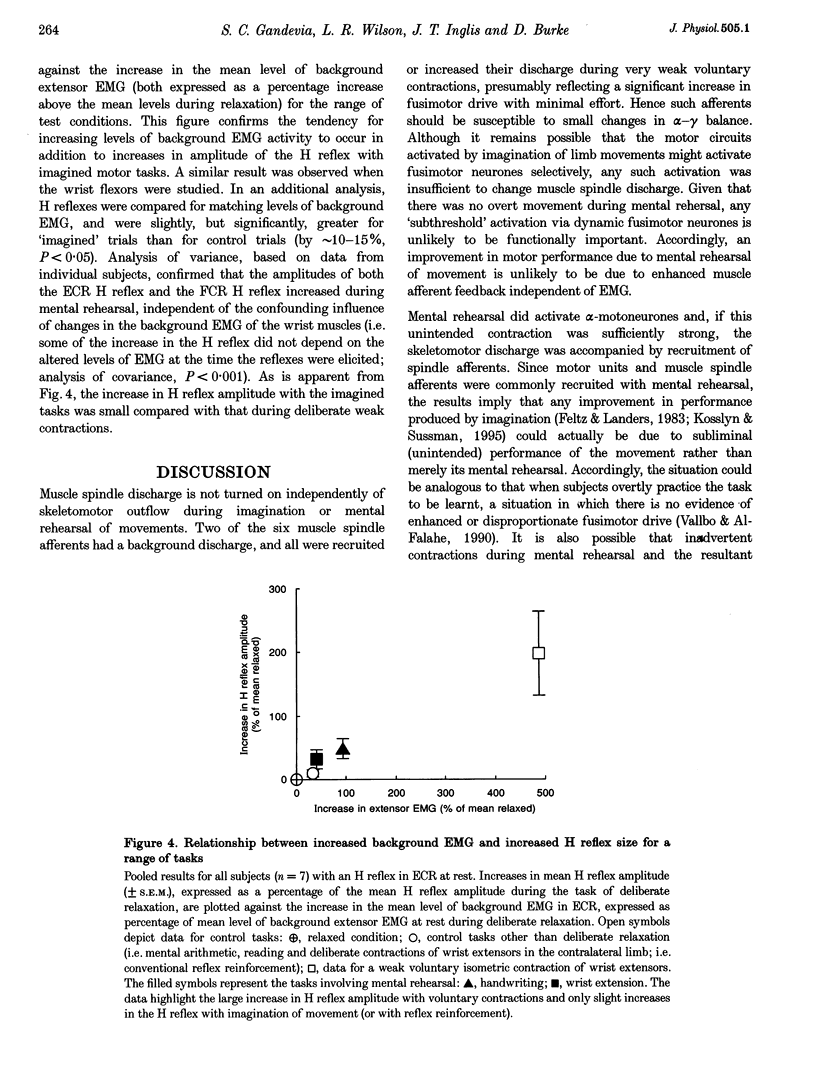
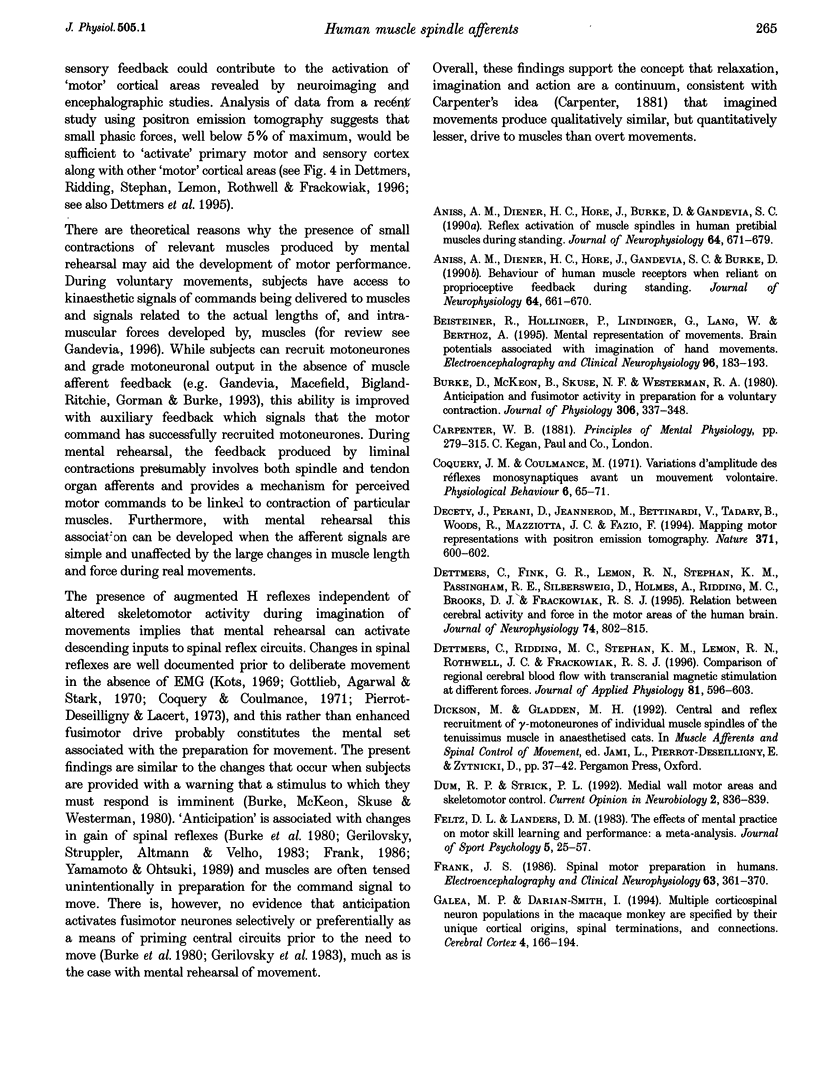
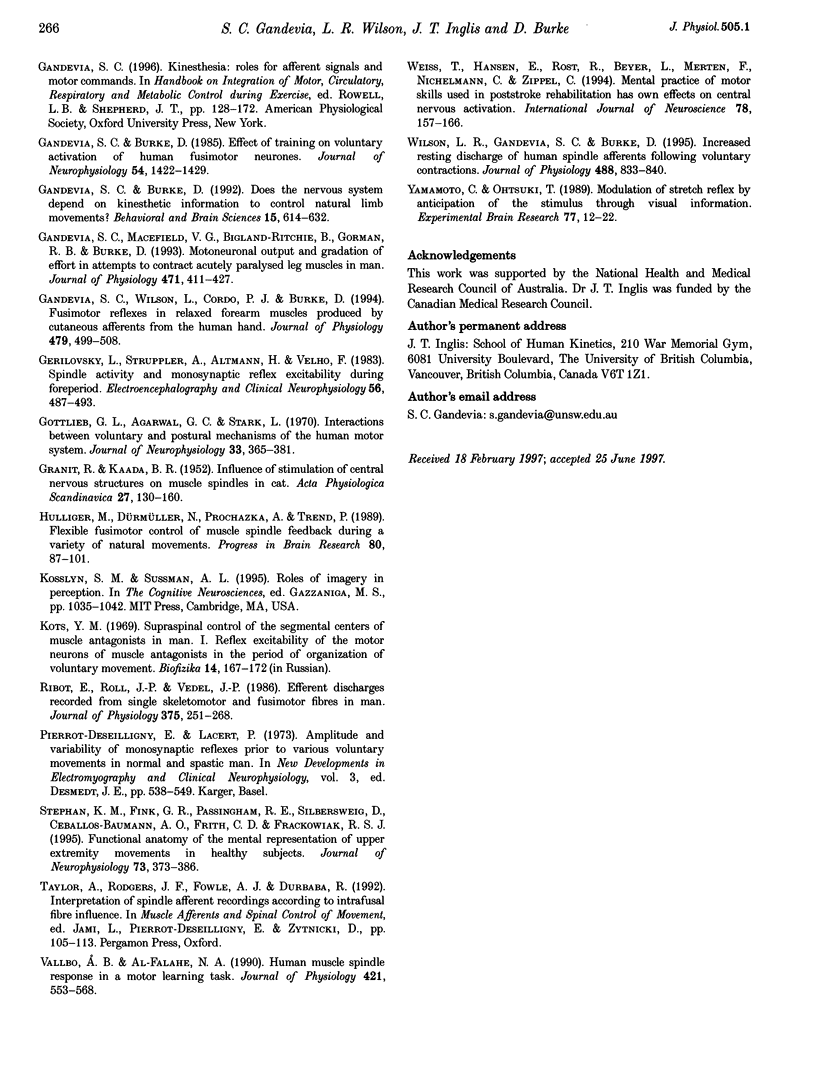
Selected References
These references are in PubMed. This may not be the complete list of references from this article.
- Aniss A. M., Diener H. C., Hore J., Burke D., Gandevia S. C. Reflex activation of muscle spindles in human pretibial muscles during standing. J Neurophysiol. 1990 Aug;64(2):671–679. doi: 10.1152/jn.1990.64.2.671. [DOI] [PubMed] [Google Scholar]
- Aniss A. M., Diener H. C., Hore J., Gandevia S. C., Burke D. Behavior of human muscle receptors when reliant on proprioceptive feedback during standing. J Neurophysiol. 1990 Aug;64(2):661–670. doi: 10.1152/jn.1990.64.2.661. [DOI] [PubMed] [Google Scholar]
- Beisteiner R., Höllinger P., Lindinger G., Lang W., Berthoz A. Mental representations of movements. Brain potentials associated with imagination of hand movements. Electroencephalogr Clin Neurophysiol. 1995 Mar;96(2):183–193. doi: 10.1016/0168-5597(94)00226-5. [DOI] [PubMed] [Google Scholar]
- Burke D., McKeon B., Skuse N. F., Westerman R. A. Anticipation and fusimotor activity in preparation for a voluntary contraction. J Physiol. 1980 Sep;306:337–348. doi: 10.1113/jphysiol.1980.sp013400. [DOI] [PMC free article] [PubMed] [Google Scholar]
- Coquery J. M., Coulmance M. Variations d'amplitude des réflexes monosynaptiques avant un mouvement volontaire. Physiol Behav. 1971 Jan;6(1):65–69. doi: 10.1016/0031-9384(71)90016-3. [DOI] [PubMed] [Google Scholar]
- Decety J., Perani D., Jeannerod M., Bettinardi V., Tadary B., Woods R., Mazziotta J. C., Fazio F. Mapping motor representations with positron emission tomography. Nature. 1994 Oct 13;371(6498):600–602. doi: 10.1038/371600a0. [DOI] [PubMed] [Google Scholar]
- Dettmers C., Fink G. R., Lemon R. N., Stephan K. M., Passingham R. E., Silbersweig D., Holmes A., Ridding M. C., Brooks D. J., Frackowiak R. S. Relation between cerebral activity and force in the motor areas of the human brain. J Neurophysiol. 1995 Aug;74(2):802–815. doi: 10.1152/jn.1995.74.2.802. [DOI] [PubMed] [Google Scholar]
- Dettmers C., Ridding M. C., Stephan K. M., Lemon R. N., Rothwell J. C., Frackowiak R. S. Comparison of regional cerebral blood flow with transcranial magnetic stimulation at different forces. J Appl Physiol (1985) 1996 Aug;81(2):596–603. doi: 10.1152/jappl.1996.81.2.596. [DOI] [PubMed] [Google Scholar]
- Dum R. P., Strick P. L. Medial wall motor areas and skeletomotor control. Curr Opin Neurobiol. 1992 Dec;2(6):836–839. doi: 10.1016/0959-4388(92)90142-8. [DOI] [PubMed] [Google Scholar]
- Frank J. S. Spinal motor preparation in humans. Electroencephalogr Clin Neurophysiol. 1986 Apr;63(4):361–370. doi: 10.1016/0013-4694(86)90021-0. [DOI] [PubMed] [Google Scholar]
- GRANIT R., KAADA B. R. Influence of stimulation of central nervous structures on muscle spindles in cat. Acta Physiol Scand. 1952;27(2-3):130–160. doi: 10.1111/j.1748-1716.1953.tb00930.x. [DOI] [PubMed] [Google Scholar]
- Gandevia S. C., Burke D. Effect of training on voluntary activation of human fusimotor neurons. J Neurophysiol. 1985 Dec;54(6):1422–1429. doi: 10.1152/jn.1985.54.6.1422. [DOI] [PubMed] [Google Scholar]
- Gandevia S. C., Macefield V. G., Bigland-Ritchie B., Gorman R. B., Burke D. Motoneuronal output and gradation of effort in attempts to contract acutely paralysed leg muscles in man. J Physiol. 1993 Nov;471:411–427. doi: 10.1113/jphysiol.1993.sp019907. [DOI] [PMC free article] [PubMed] [Google Scholar]
- Gandevia S. C., Wilson L., Cordo P. J., Burke D. Fusimotor reflexes in relaxed forearm muscles produced by cutaneous afferents from the human hand. J Physiol. 1994 Sep 15;479(Pt 3):499–508. doi: 10.1113/jphysiol.1994.sp020313. [DOI] [PMC free article] [PubMed] [Google Scholar]
- Gerilovsky L., Struppler A., Altmann H., Velho F. Spindle activity and monosynaptic reflex excitability during foreperiod. Electroencephalogr Clin Neurophysiol. 1983 Nov;56(5):487–493. doi: 10.1016/0013-4694(83)90233-x. [DOI] [PubMed] [Google Scholar]
- Gottlieb G. L., Agarwal G. C., Stark L. Interactions between voluntary and postural mechanisms of thehuman motor system. J Neurophysiol. 1970 May;33(3):365–381. doi: 10.1152/jn.1970.33.3.365. [DOI] [PubMed] [Google Scholar]
- Hulliger M., Dürmüller N., Prochazka A., Trend P. Flexible fusimotor control of muscle spindle feedback during a variety of natural movements. Prog Brain Res. 1989;80:87–60. doi: 10.1016/s0079-6123(08)62202-5. [DOI] [PubMed] [Google Scholar]
- Ribot E., Roll J. P., Vedel J. P. Efferent discharges recorded from single skeletomotor and fusimotor fibres in man. J Physiol. 1986 Jun;375:251–268. doi: 10.1113/jphysiol.1986.sp016115. [DOI] [PMC free article] [PubMed] [Google Scholar]
- Stephan K. M., Fink G. R., Passingham R. E., Silbersweig D., Ceballos-Baumann A. O., Frith C. D., Frackowiak R. S. Functional anatomy of the mental representation of upper extremity movements in healthy subjects. J Neurophysiol. 1995 Jan;73(1):373–386. doi: 10.1152/jn.1995.73.1.373. [DOI] [PubMed] [Google Scholar]
- Vallbo A. B., al-Falahe N. A. Human muscle spindle response in a motor learning task. J Physiol. 1990 Feb;421:553–568. doi: 10.1113/jphysiol.1990.sp017961. [DOI] [PMC free article] [PubMed] [Google Scholar]
- Weiss T., Hansen E., Rost R., Beyer L., Merten F., Nichelmann C., Zippel C. Mental practice of motor skills used in poststroke rehabilitation has own effects on central nervous activation. Int J Neurosci. 1994 Oct;78(3-4):157–166. doi: 10.3109/00207459408986054. [DOI] [PubMed] [Google Scholar]
- Wilson L. R., Gandevia S. C., Burke D. Increased resting discharge of human spindle afferents following voluntary contractions. J Physiol. 1995 Nov 1;488(Pt 3):833–840. doi: 10.1113/jphysiol.1995.sp021015. [DOI] [PMC free article] [PubMed] [Google Scholar]
- Yamamoto C., Ohtsuki T. Modulation of stretch reflex by anticipation of the stimulus through visual information. Exp Brain Res. 1989;77(1):12–22. doi: 10.1007/BF00250562. [DOI] [PubMed] [Google Scholar]


